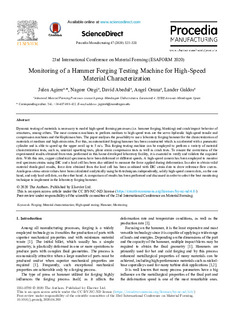| dc.rights.license | Attribution-NonCommercial-NoDerivatives 4.0 International | * |
| dc.contributor.author | Agirre, Julen | |
| dc.contributor.author | Otegi, Nagore | |
| dc.contributor.author | Abedul Moreno, David | |
| dc.contributor.author | Oruna Otalora, Angel | |
| dc.contributor.author | GALDOS, Lander | |
| dc.date.accessioned | 2020-05-26T13:59:08Z | |
| dc.date.available | 2020-05-26T13:59:08Z | |
| dc.date.issued | 2020 | |
| dc.identifier.issn | 2351-9789 | en |
| dc.identifier.other | https://katalogoa.mondragon.edu/janium-bin/janium_login_opac.pl?find&ficha_no=158170 | en |
| dc.identifier.uri | https://hdl.handle.net/20.500.11984/1662 | |
| dc.description.abstract | Dynamic testing of materials is necessary to model high-speed forming processes (i.e. hammer forging, blanking) and crash/impact behavior of structures, among others. The most common machines to perform medium to high-speed tests are the servo-hydraulic high-speed tensile and compression machines and the Hopkinson bars. The paper analyses the possibility to use a laboratory forging hammer for the characterization of materials at medium and high strain rates. For this, an automatized forging hammer has been constructed which is accelerated with a pneumatic cylinder and is able to speed up the upper anvil up to 5 m/s. This forging testing machine can be employed to perform a variety of material characterization tests, such as, uniaxial upsetting tests, plane strain compression tests as well as crash tests. To ensure the correctness of the experimental results obtained from tests performed in this home-developed laboratory facility, it is essential to verify and validate the acquired data. With this aim, copper cylindrical specimens have been deformed at different speeds. A high-speed camera has been employed to monitor real specimen strains using DIC and a load cell has been also utilized to measure the force applied during deformation. In order to obtain valid material rheological results, force data obtained from the load cell has been combined with DIC strain data to draw reference flow curves. Analogous stress-strain values have been calculated analytically using both techniques independently, solely high-speed camera data, on the one hand, and only load-cell data, on the other hand. A comparison of results has been performed and discussed in order to select the best monitoring technique to implement in the laboratory forging hammer. | en |
| dc.description.sponsorship | Gobierno Vasco | es |
| dc.language.iso | eng | en |
| dc.publisher | Elsevier Ltd. | en |
| dc.rights | © 2020 The Authors | en |
| dc.rights.uri | http://creativecommons.org/licenses/by-nc-nd/4.0/ | * |
| dc.subject | forging | en |
| dc.subject | Material characterization | en |
| dc.subject | High-speed testing | en |
| dc.subject | Hammer | en |
| dc.subject | Monitoring | en |
| dc.title | Monitoring of a Hammer Forging Testing Machine for High-Speed Material Characterization | en |
| dc.type | http://purl.org/coar/resource_type/c_6501 | |
| dcterms.accessRights | http://purl.org/coar/access_right/c_abf2 | en |
| dcterms.source | Procedia Manufacturing | en |
| local.description.peerreviewed | true | en |
| local.description.publicationfirstpage | 321 | en |
| local.description.publicationlastpage | 328 | en |
| local.identifier.doi | https://doi.org/10.1016/j.promfg.2020.04.260 | en |
| local.relation.projectID | GV/Programa de apoyo a la I+D Empresarial Hazitek 2019/ZL-2019-00161/CAPV/Piezas forjadas de prestaciones extremas para el sector Oil & Gas mediante procesos de forja eficientes optimizados por modelos complejos de evolución microestructural/OGFORGE | en |
| local.source.details | Vol. 47. Pp. 321-328, 2020 | eu_ES |
| oaire.format.mimetype | application/pdf | |
| oaire.file | $DSPACE\assetstore | |
| oaire.resourceType | http://purl.org/coar/resource_type/c_6501 | en |
| oaire.version | http://purl.org/coar/version/c_970fb48d4fbd8a85 | en |








